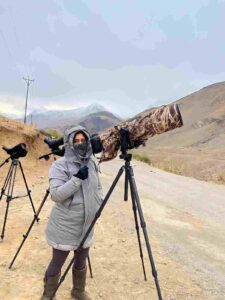When Latika Nath was only six weeks old, her parents took her on her first fishing trip. When Nath turned one, she got a Siamese cat and a golden retriever puppy. Slowly and steadily, she took a deep interest in wild animals. Trips to National Parks and forests with her father made her fall in love with nature.
Meet India’s Tiger Princess, the first female wildlife biologist of India, a Conservation Ecologist, a TEDx speaker, and a great Author, Latika Shah whose contribution has made its way into Discovery Channel’s ‘Wild Things’, popular films like ‘Tale of Two Tigers’ by BBC, and ‘Sita’s Story’.
When children of her age were busy playing in the streets or listening to their favourite songs, Latika had dreamt of becoming an ecologist. The walls of her rooms were adorned with tiger photographs by Chuck McDougall, taken in the 1970s.
After completing her undergraduate degree in Environmental Science from Delhi University, she went to the School of Forestry, University of Wales. Later, she secured her doctorate from the University of Oxford.
We connected with this leading lady who has worked on various conservation projects and will continue to serve the nation.
1. Conservationists often develop unique bonds with the animals they work to protect. Can you share a heartwarming or memorable interaction you’ve had with a tiger or another wild creature?
I have had many heartwarming experiences, one of the favourites was with a tigress named Sita in Bandhavgarh. She was the main tiger I was studying for my Ph.D. She treated us like our family. The minute we would arrive, she would let her cubs play around us while she would peacefully rest or go to sleep. It was incredibly amazing and fun at the same time. We could spend hours with each other. She would go off, leaving them with us. My interactions with Sita and her cubs were not just research moments; they were moments of pure joy.

2. As an ecologist, you likely spend a lot of time in the forests. Can you describe a moment in the wild that left you in awe of the natural world?
Every encounter with a big cat in the wild changes you and creates a lasting memory in your heart. While there isn’t just one moment that stands out, I have had an unforgettable experience with my first snow leopard. I spent the whole afternoon, close to four hours with that leopard. It was right on the ridge and kept calling and communicating with me.
As the day turned to dusk, we had to leave because we were way away from our camp. And the leopard literally kept calling us back, as if it didn’t want us to go. It was a truly surreal and unforgettable experience that showcased the deep connection we can form with the natural world.
3. India has made significant strides in tiger conservation over the years. What are some of the key conservation initiatives you’ve been involved in?
I’ve been actively involved in Project Tiger and have also done a lot of work on human-wildlife conflict resolution, high-altitude animal conservation, and more.
As a conservationist, I have a lot to contribute to the country. Currently, I serve on the National Tourism Advisory, which provides me with a platform to guide and influence policy and decision-making in the conservation arena. Furthermore, I regularly guide and do a lot of public speaking which helps me influence people and guide the direction of conservation. So I think I have a lot to offer. I’m hopeful that the government will provide me the opportunities to make a meaningful impact in the field of conservation.

4. How do you see the future of tiger conservation in India, and what are your hopes and goals for the coming years?
Tiger conservation has been a one-sided effort to increase Tiger numbers; it was not a balanced initiative. They didn’t adequately consider the habitat carrying capacity and the creation of new habitats for larger numbers of tigers which resulted in a sharp increase in Tiger-human conflict.
I believe that in the coming decade, we need to put more emphasis on improving the capacity of existing habitats, creating new habitats, reducing Tiger human conflict, focusing on using food & water availability, and improving the overall tourism experience. This approach promotes sustainable tourism and conservation efforts that contribute positively to the environment.
“The fact that the entire country knows me as ‘India’s Tiger Princess’ fills me with a deep sense of responsibility. I will continue to contribute to the nation to justify the affection, respect, and the title that people have given me.”
Read More Inspiring Stories:
- Vrikshit Foundation: An NGO Encouraging Masses To Strive For A Healthier India
- Here’s Why Shubhi’s Unique Approach To Managing Traffic Is Doing Wonders
- Meet 68-Year-Old Doctor-Model Who Is An Inspiration To Many
- Echoes: A Cafe That Converses Without Any Language
- Meet The Man Behind Female Voice Of Railway Announcements



